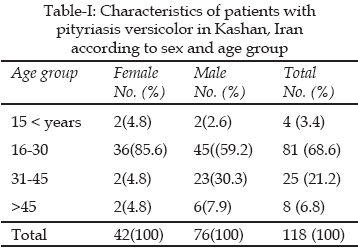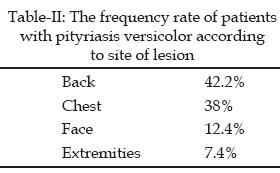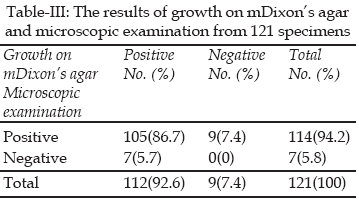|
 |
|
Published
by : PROFESSIONAL MEDICAL PUBLICATIONS |
|
ISSN 1681-715X |
|
|
|
|
|
- |
|
ORIGINAL
ARTICLE |
|
- |
|
Volume 25 |
October - December 2009
(Part-I) |
Number 5 |
|
|
|
Isolation and identification of Malassezia spp.
In pytiriasis versicolor in Kashan, Iran
Rezvan Moniri1, Mehdi Nazeri2, Shokouh
Amiri3, Babak Asghari4
ABSTRACT
Objective: Pityriasis versicolor (PV) is a chronic
superficial fungal disease caused by Malassezia spp. The incidence is
as high as 30-40% in tropical climates. Epidemiological data suggest
geographical variations in the rate of the isolated species from PV. Our aim
was to identify Malassezia spp. from PV patients in Kashan, Iran.
Methodology: Isolates of Malassezia were collected
from 118 PV patients (75 males and 43 females). A direct microscopy
with KOH and methylene blue was carried out. Cultures were made in modified
Dixon agar medium and the isolates were identified by macroscopic and
microscopic features, physiological characteristics (catalase test) and
biochemical criteria (esculin and lipid assimilation tests). Data were
analyzed statistically by software SPSS (version 11) and Fischer’s exact and
descriptive statistical tests.
Results: The average age of 118 patients in this
study was 28.42±8.53 years. The percentages of patients in this study were
64.4 and 35.6 for men and women respectively. Hyperhydrosis was reported as
the most important finding with 58.1%. Back (42.2%) and extremities (7.4%)
were the highest and the lowest involved parts respectively. The isolates
found were M. globosa (43.8%), Malassezia furfur (38.4%), M.
obtusa (9.8%), M. sympodialis (6.3%), and M. slooffiae
(1.7%).
Conclusion: From these findings it was suggested
that M. globosa presents the main species implicated in the
pathogenicity of PV and M. furfur as the second agent of importance.
KEY WORDS:
Malassezia spp, Pityriasis versicolor.
Pak J Med Sci October - December 2009
(Part-I) Vol. 25 No. 5 837-840
How to cite this article:
Moniri R, Nazeri M, Amiri S, Asghari B. Isolation and identification of
Malassezia spp. In pytiriasis versicolor in Kashan, Iran. Pak J Med Sci
2009;25(5):837-840.
1. Rezvan Moniri,
Associate Professor of Microbiology,
Dept. of Microbiology and Immunology,
2. Mehdi Nazeri
Dept. of Mycology,
1,2: Kashan University of Medical Sciences,
Kashan - Iran.
3. MR Shokouh Amiri
Dept. of Mycology,
Tarbieyat Moddares,
Tehran University of Medical Sciences, Iran
4. Babak Asghari
Master of Medical Microbiology
Imam Hasan Mojtaba Hospital,
Iran University of Medical Sciences,
Iran.
Correspondence
Rezvan Moniri,
Associate Professor of Microbiology,
Dept. of Microbiology and Immunology,
Kashan University of Medical Sciences,
P.O.Box: 87155-111
Kashan – Iran.
E-mail: moniri@kaums.ac.ir
* Received for Publication: December 3, 2008
* Revision Received: July 18, 2009
* Revision Accepted: July 24, 2009
INTRODUCTION
Pityriasis versicolor
(PV) is a superficial infection of the stratum corneum caused by Malassezia
spp.,1
pathological change occurred by inoculating them onto human skin, and they
were detected from the pathological change.2
PV varies depending on tropical or temperate climate. Patients with PV
increase in summer. PV is observed in the 20 to 30 year old group, but is
uncommon in children and the elderly.3,4
PV is not uncommon among children in the tropics.5
PV is diagnosed by its clinical appearance and the observation of many yeast
cells and hyphae in scales stained with methylene blue or KOH in microscopic
examination. Malassezia species are lipophilic yeasts and are
considered part of the normal flora of the skin, being particularly common on
the scalp, face and trunk. Sei et al.,6
reported that the number of Malassezia species on the face increased
for one month after birth, and started to decrease four months later in
parallel with the amount of sebum. Until recently, M. furfur, M.
pachydermatis, and M. sympodialis were the only members of the
genus, but in 1996, Gue´ho et al. added four new species, M. globosa,
M. obtusa, M. restricta, and M. slooffiae, based on their
morphology, ultrastructure, physiology, and molecular biology.7
Recently, four new species were isolated, namely M.
dermatis,
8
M. japonica,9
M. yamatoensis10
and M. nana11
in Japan. Malassezia species are associated with PV, Malassezia folliculitis,
seborrheic dermatitis (SD), dandruff, atopic dermatitis (AD)12
and CRP.13
Research attention has focused on the relationship between Malassezia species
and skin disease. Until recently, PV was a superficial infection believed to
be caused by M. furfur. Recent studies14-16
using morphological features and physiological tests indicate that M.
globosa may actually be the causative agent, but the M. globosa
rate of culture changed with reporters from 53 to 97%. On the other hand,
Gupta et al.,17
reported that M. sympodialis was detected at 60%. Nakabayashi18
reported that M. globosa was isolated from 55% of lesional skin
specimens in PV, while other species were below 10% according to the method
devised by Guillot et al.19
The present study was aimed to identify the Malassezia spp. causing
pityriasis versicolor in a Kashan population in Iran.
METHODOLOGY
This descriptive study was conducted from August 2006 to
October 2007.The samples were collected from patients with pityriasis
versicolor in Kashan, Iran and processed in the mycology laboratory of the
department of microbiology. Mycological evaluation by microscopic examination
of KOH treated skin scrapings and methylene blue staining were done and 118
were cultured. The scales were inoculated into modified Dixon’s agar (mDixon’s
agar) as described by Guillot et al and into Sabouraud dextrose agar
containing 0.05% chloramphenicol and 0.05% cycloheximide (SDA). The tubes were
incubated at 32°C for 3-4 days. The morphology of the yeast cells was studied
by making Gram stained smears of the isolates from mDixon’s agar after one
week incubation at 32°C. Ethical approval for the study was obtained from
Research and Ethics Committee of the Kashan University of Medical Sciences.
RESULTS
The average age of 118 patients (76 males and 42 females)
in this study was 28.42±8.53 years. Characteristics of patients with
pityriasis versicolor in Kashan, Iran according to sex and age group shown in
Table-I.

One hundred fourteen (94.2%) skin scrapings showed hyphae
and spores in the KOH preparation. Growth was obtained on mDixon’s agar 112
out of 121(92.6%) skin scrapings. The isolates found were M. globosa
(43.8%), Malassezia furfur (38.4%), M. obtusa (9.8%), M.
sympodialis (6.3%), and M. slooffiae (1.7%). There was no
statistically significant association between Malassezia spp. and demographic
characteristics and clinical characteristics of the patients. Hyperhydrosis
was reported as the most important finding with 58.1%. The frequency rate of
patients with pityriasis versicolor according to site of lesion are shown in
Table - II.

DISCUSSION
In our study, out of the 118 specimens that were inoculated,
92.6% yielded growth of Malassezia in culture. Out of this, the
most frequently isolated species was Malassezia globosa (43.8%),
followed by M.furfur (38.4%), M. obtusa (9.8%), M.
sympodialis(6.3%) and M. slooffiae(1.7%). 42.2% of isolates,
predominating in the back skin.

In an earlier study, Crespo et al reported that
M.globosa was recovered from 97% of their patients, alone in 60% of them
and associated with M.sympodialis in 29% and M. slooffiae
in 7%.
14
Crespo Erchiga et al. showed that in pityriasis versicolor, Malassezia
globosa was found in 84% of cases, alone or associated with Malassezia
sympodialis, which was by far the commonest species in normal skin (91.7%
of isolates, predominating in the trunk skin).,20
Kindo et al., described that out of 70 scrapings 48 (68.75%) showed growth on
mDixon’s agar. The commonest isolate was M. sympodialis (28, 58%)
followed by M. globosa (19, 40%) and one isolate was (2%) of M.
restricta.21
Salah et al. reported that Malassezia globosa was the predominant
species in lesional skin of PV (65%). It was isolated alone in 47% of cases
and associated in 18% with M. furfur (13%) or M. sympodialis
(5%). In healthy skin M. globosa was found alone in 7.77% and
associated in 15.54%, respectively, with M. furfur (4.44%), M.
sympodialis (4.44%), M. restricta (3.33%) and M. slooffiae
(1.11%).22
Crespo-Erchig et al. indicated that Malassezia globosa is the
predominant species found in the lesions of pityriasis versicolor, at least in
temperate climates.23
In a study by Krisanty et al. the isolates found were
Malassezia furfur (42.9%), M. sympodialis (27.5%), M. globosa
(13.3%), M. slooffiae (7.7%), M. obtusa (7.7%) and M.
restricta (2.2%), and 7.14% specimens were unidentified
24
Karakaº et al. reported that 45.4% of the patients showed Malassezia spp. in
culture and Malassezia globosa (47.7%) was the most commonly isolated
species followed by Malassezia furfur (36.4%) and Malassezia
slooffiae (15.9%).25
In this study, the most common isolated species in PV lesions was M.
globosa, which is in agreement with the majority of studies worldwide.20,22,23,25,26
This was contrary to observation of Krisanty et al., which isolated M.
furfur and M. sympodialis as the predominant species in PV lesions.24
From these findings it was suggested that M. globosa
presents the main species implicated in the pathogenicity of pityriasis
versicolor and M. furfur as the second agent of importance, and
predominating site of infection was in the back skin.
ACKNOWLEDGEMENTS
The financial support of the Kashan University of Medical
Sciences and Health Services is gratefully acknowledged. We are also grateful
to Dr. Morraveji for his valuable advice in this study. Conflict of
interest: No competing interest declared.
REFERENCES
1. Morishita N, Sei Y, Sugita T. Molecular analysis of
Malassezia microflora from patients with pityriasis versi-color.
Mycopathologia 2006;161:61–65.
2. Faergemann J, Frediksson T. Experimental infection in
rabbits and humans with Pityrosporum orbiculare and P ovale. J Invest Dermatol
1981;77:314–318.
3. Kasai T. Epidemiological investigation committee for
human mycoses in the japanese society for medical mycology. 1997
epidemiological survey of dermatophytoses in Japan. Nippon Ishinkin Gakkai
Zasshi 2001;42:11–18.
4. Tan HH. Superficial fungal infections seen at the
National Skin Centre, Singapore. Nippon Ishinkin Gakkai Zasshi 2005;46:77–80.
5. Jena DK, Sengupta S, Dwari BC, Ram MK. Pityriasis
versicolor in the pediatric age group. Ind J Dermatol Venereol Leprol
2005;71:259–261.
6. Sei Y, Nakabayashi A, Morishita N, Takiuchi I. Infantile
Seborrheic Dermatitis-The etiology and role of Malassezia furfur. J Pediat
Dermatol 2000;19:101–104.
7. Gue´ho E, Midgley G, Guillot J. The genus Malassezia
with description of four new species. Antonie van Leeu-wenhoek
1996;69:337–355.
8. Sugita T, Takashima M, Shinoda T. New Yeast Species,
Malassezia dermatis, Isolated from Patients with Atopic Dermatis. J Clin
Microbiol 2002;40:1363–1367.
9. Sugita T, Takashima M, Kodama M. Description of a New
Yeast Species, Malassezia japonica, and its Detection in Patients with Atopic
Dermatitis and Healthy Subjects. J Clin Microbiol 2003;41:4695–4699.
10. Sugita T, Tajima M, Takashima M. A New Yeast,
Malassezia yamatoensis, isolated from a Patient with Seborrheic Dermatitis,
and Its Distribution in Patients and Healthy Subjects. Microbiol Immunol
2004;48:579–583.
11. Hirai A, Kano R, Makimura K. Malassezia nana sp Nov, a
novel lipid-dependent yeast species isolated from animals. Int J Syst Evol
Microbiol 2004;54:623–627.
12. Gupta AK, Batra R, Bluhm R. Skin disease associated
with Malassezia species. J Am Acad Dermatol 2004;51:85–798.
13. Stein JA, Shin HT, Chang MW. Confluent and reticulated
papillomatosis associated with tinea versicolor in three siblings. Pediatr
Dermatol 2005;22:331–333.
14. Crespo EV, Ojeda MA, Vera CA. Malassezia globosa as the
causative agent of pityriasis versicolor. Brit J Dermatol 2000;143:799–803.
15. Aspiroz C, Ara M, Varea M. Isolation of Malassezia
globosa and M.sympodialis from patients with pityriasis versicolor in Spain.
Mycopathologia 2001;154:111–117.
16. Tarazooie B, Kordbacheh P, Zaini F. Sutudy of the
distribution of Malassezia species in patients with pityriasis versicolor and
healthy individuals in Tehran, Iran. BMC Dermatol 2004;4:5.
17. Gupta AK, Kohli Y, Faergemann J, Summerbell RC.
Epidemiology of Malassezia yeasts associated with pity-riasis versicolor in
Ontario,Canada. Med Mycol 2001;39:199–206.
18. Nakabayashi A, Sei Y, Guillot J. Identification of
Malassezia species isolated from patients with seborrhoeic dermatitis, atopic
dermatitis, pityriasis versicolor and normal subjects. Med Mycol
2000;38:337–341.
19. Guillot J, Gue´ho E, Lesourd M. Identification of
Malassezia species, A practical approach. J Mycol Med 1996;6:103–110.
20. Crespo Erchiga V, Ojeda Martos AA, Vera Casaño A,
Crespo Erchiga A, Sánchez Fajardo F. Isolation and identification of
Malassezia spp. In pytiriasis versicolor, seborrheic dermatitis and healthy
skin. Rev Iberoam Micol 1999;16(S):S16-21.
21. Kindo AJ, Sophia SK, Kalyani J, Anandan S.
Identification of Malassezia species. Indian J Med Microbiol 2004;
22(3):179-81.
22. Salah SB, Makni F, Marrakchi S. Identification of
Malassezia species from Tunisian patients with pityriasis versicolor and
normal subjects. Mycoses. 2005;48(4):242-5.
23. Crespo-Erchiga V, Florencio VD. Malassezia yeasts and
pityriasis versicolor. Curr Opin Infect Dis 2006;19(2):139-47.
24. Krisanty RI, Bramono K, Made Wisnu I. Identification of
Malassezia species from pityriasis versicolor in Indonesia and its
relationship with clinical characteristics. Mycoses 2009;52(3):257-62.
25. Karakaº M, Turaç-Biçer A, Ilkit M, Durdu M, Seydaoðlu
G. Epidemiology of pityriasis versicolor in Adana, Turkey. J Dermatol
2009;36(7):377-82.
26. Tarazooie B, Kordbacheh P, Zaini F, Zomorodian K, Saadat F, Zeraati H,
et al. Study of the distribution of Malassezia species in patients with
pityriasis versicolor and healthy individuals in Tehran, Iran. BMC Dermatol
2004;4:1,5.
HOME
| SEARCH
| CURRENT
ISSUE | PAST
ISSUES
Professional
Medical Publications
Room No. 522, 5th Floor, Panorama Centre
Building No. 2, P.O. Box 8766, Saddar, Karachi - Pakistan.
Phones : 5688791, 5689285 Fax : 5689860
pjms@



